The next contender for our drop-in AR-15 trigger dollars is the KE Arms DMR Trigger, and at ~$180 it’s priced lower than much of the competition. Available in both the gold TiN coating seen here or in black Melonite, the KE trigger is highly adjustable and well-made. Let’s dive in for a closer look. . .
Despite an MSRP that’s solidly below average among its drop-in trigger unit peers, KE keeps the quality top notch. Build breaks down as follows:
- trigger shoe, hammer, and disconnector are wire EDM-cut from A2 tool steel
- trigger shoe, hammer, and disco are TiN (Titanium Nitride) coated
- housing is machined from aluminum then anodized blue
Trigger/hammer/disco are all a full, 1/4″ width to maximize strength and long-term durability. This can boost the safety factor, too, through large engagement surfaces.
Two set screws protrude from the bottom of the housing for tensioning the KE unit inside of the receiver. They push the unit up against the trigger pins, locking everything in place and dialing out any wiggle. The hammer spring has short “legs” to allow for easy access of these tensioning set screws, but the spring still feels full-power or close to it.
The other adjustment offered on the KE Arms DMR is that of trigger pull weight. By turning another set screw the end user can increase or decrease the amount of force necessary to trip the sear. Maximum adjustment range doesn’t seem to be specified, but pull weights in the 3- to 4.5-lb range are definitely possible and a larger spread is likely possible.
On The Range
To maintain continuity across all of these drop-in trigger reviews, including the ELF Tactical, Velocity Triggers, and CMC Triggers review already published, we’ll rate them on the same metrics. For definitions of the following trigger fundamentals, please see that ELF Tactical review.
- Take-up, which is also referred to as pre-travel or slack. The trigger itself has no take-up. It’s a single stage and it’s right up on the sear at rest.
- Creep. If I pull the KE trigger shoe about as slowly as possible, I can feel the creep as the trigger/sear surfaces slide apart. It’s smooth and so short in pull distance that it’s entirely unnoticeable outside of that pulling-as-slowly-as-possible scenario.
- Break. Perfectly clean and crisp. Instant and complete snap from full pull weight to zero.
- Overtravel. Quite short. Very little excess travel. Hard stop at the end.
- Reset. The only little nit to pick on the KE trigger is the littlest bit of grit on the reset travel. If you’re letting the trigger out slowly, you can feel the disconnector sliding off the hammer hook. A dab of grease would cure this, but I shot it as it came from the factory, which is basically lube-free thanks to the TiN coating. Same story with the Velocity Trigger, but the Robar NP3 coating on the Velocity is slicker so that grit isn’t there. A minor gripe, for sure, as once again if you’re shooting at a normal or a fast pace this grit cannot be felt. Reset travel is slightly shorter than average, and the click is nicely tactile and audible.
- Pull Weight. Pull weight on the KE DMR trigger is user adjustable. Mine measured a consistent 3 lbs, 3 oz from the factory and I saw no need to mess with it from there. Not for range and target shooting, at least. The ability to bump it up closer to 5 lbs is welcome should it be chosen for defensive type use.
I shot a handful of IMI 5.56, Federal 5.56, and a bunch of Silver Bear .223 with the KE installed, and it had zero issues. Despite the fairly hard primers found in this ammo, they were dented with authority. The trigger was totally reliable throughout, both suppressed and unsuppressed.
The trigger blade feels good and looks good. I dig the gold TiN — although it’s already gone on most of the wear surfaces — but the option of black Melonite is nice for keeping things more subdued. KE’s DMR Trigger is a great, single-stage trigger for precision shooting and it’s a very fast trigger for 3-gun style competition use or just for fun on the range.
Conclusion
This is an excellent trigger. It looks good, it feels good, it shoots well, it’s definitely high quality, and it’s awesome on the fundamentals. If there’s any chink in the DMR’s armor, though, it’s that the Velocity Trigger checks all the same boxes in almost identical fashion for less money (MSRP is $40 less, and “street price” shows a larger disparity). That said, a rifle is often a long-term investment so if there’s something about the KE that’s more appealing, such as the aesthetics of the gold TiN coating, then $40 over the lifetime of an AR-15 is nothing.
Also, shout-out and thanks to Strike Industries for sending me a trigger jig to make this back-to-back testing so much easier.
RATINGS (out of five stars, compared to other drop-in AR triggers):
Fundamentals: * * * *
Without the back-to-back experience of the other triggers, I’d rate this five stars. But this ~10-trigger roundup will [probably] have one on top and one at bottom, and the KE DMR Trigger is amazing but is second fiddle to the ELF on fundamentals. It’s effectively in a dead heat with the Velocity Trigger here, as they feel nearly identical except for the teeny bit of grit in the KE’s reset…if you’re looking to find it.
Features: * * * *
Set screws for receiver tension, pull weight adjustment, full width internals, TiN (or Melonite) finish.
Price: * * * *
MSRP of $189.95 — although I have never seen it on KE’s site for other than $179.95 — puts it below average (for drop-in units) for a rating above average.
Overall: * * * *
I’m calling this one a dead heat with the Velocity Trigger, but knocking off a half star since the KE DMR costs more and I think the Velocity’s NP3 coating is functionally superior. No matter how you spin it, though, KE’s DMR is an absolutely excellent trigger.


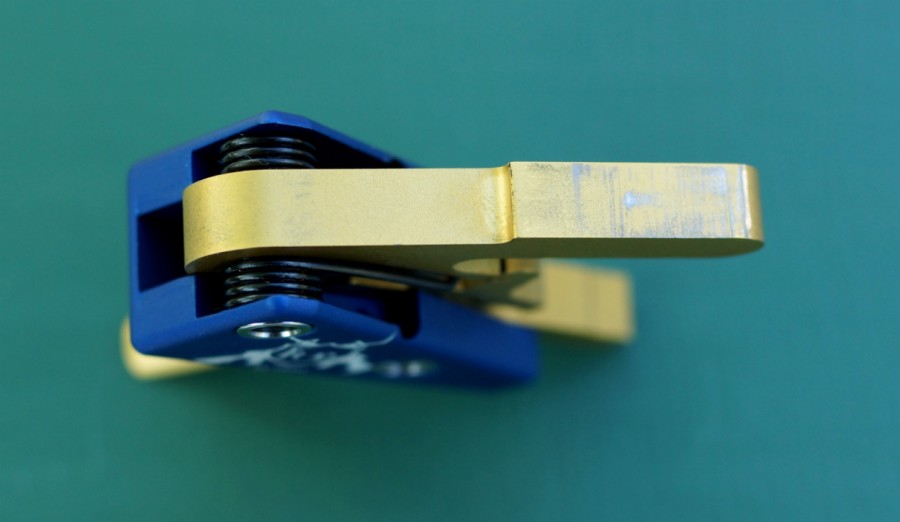
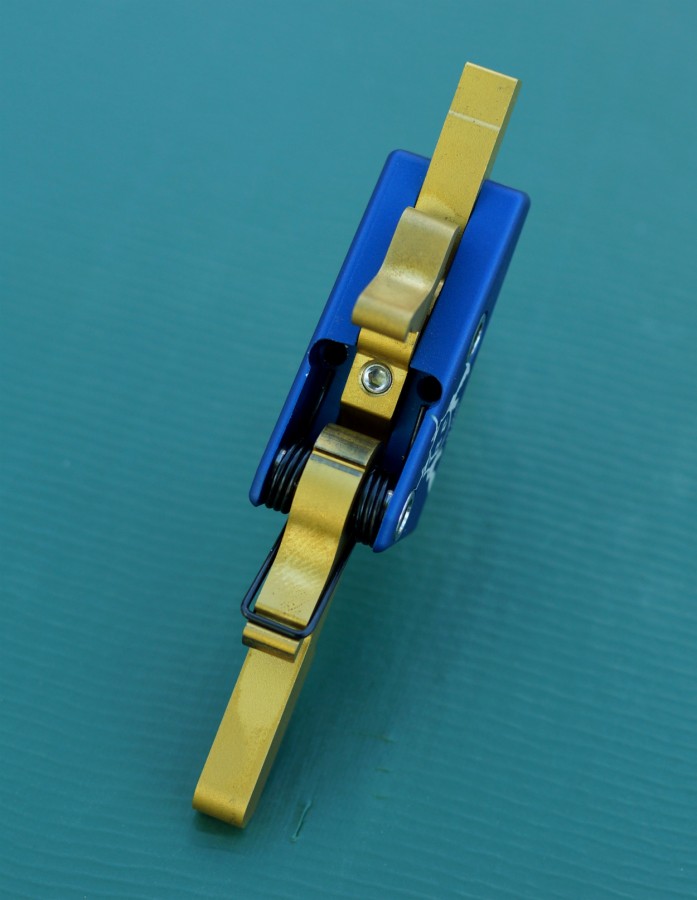
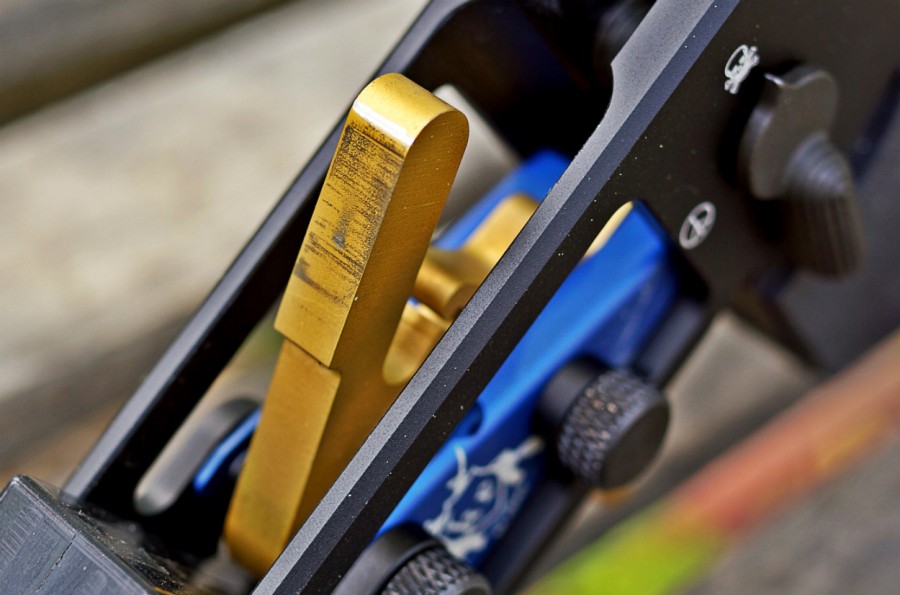
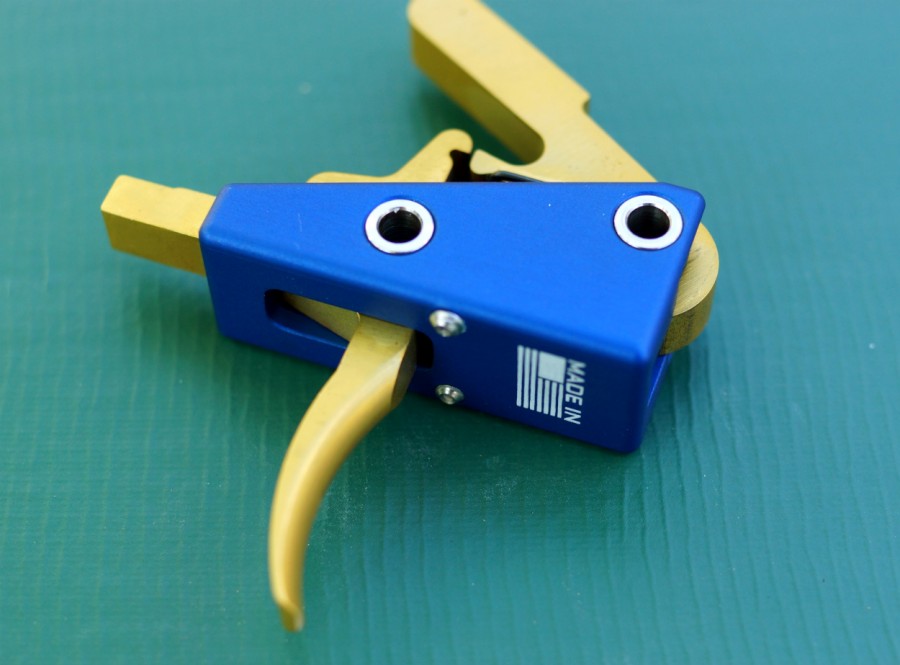
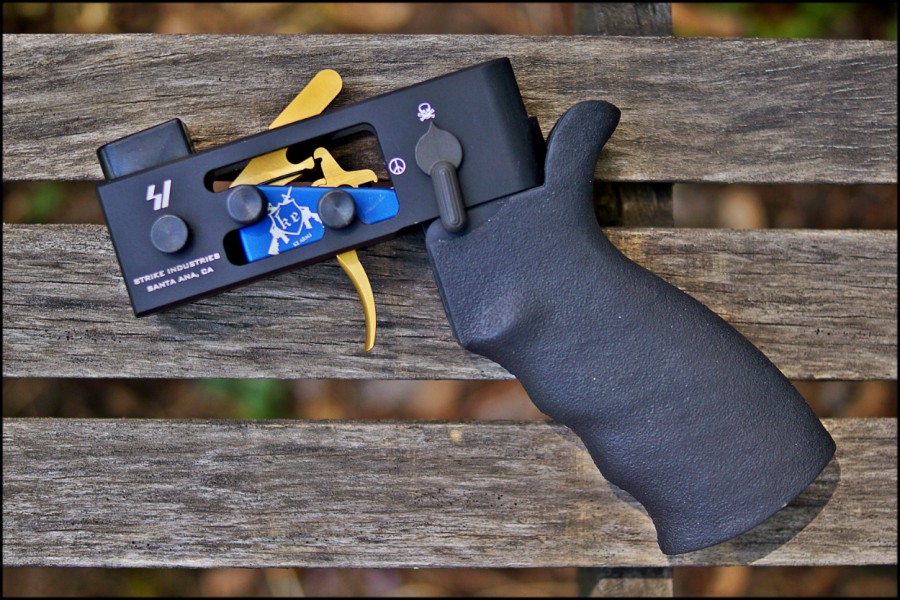



Nice review, Jeremy. How would you rate this trigger against a similar, single-stage Geissele trigger?
I’m trying to stick to comparing drop-in units at the moment, but the SD3G can hold its own against most anything out there. It actually has more creep than some of these really good drop-ins, though, including the KE unit reviewed here, but it’s still minimal. My personal preference would go to full width tool steel components rather than cast parts. Not that anyone has ever had any issues w/ Geissele triggers, as the quality of their castings is extremely good and the finishing process on them is very extensive, but they are investment cast and at a minimum I enjoy looking at and feeling a machined part better. It’s very close on trigger pull quality so I’d have a hard time spending more money. In fact, I’m still of the personal opinion that, on a budget, I’d get the Velocity and with no price concern I’d get the ELF. But there are more triggers to test…
I’m also still working on that loan of the TriggerScan testing equipment so we can actually quantify the fundamentals of each trigger. As in, legit measurements for creep, overtravel, weight, etc… even how clean the break is can be seen.
Thanks! I appreciate the informed and honest response.
I don’t get this disparagement of investment cast parts in guns. I seriously don’t.
Most of Ruger’s gun parts are investment cast, including their receivers. Even the barrels are, on their smallest revolvers.
You can machine a casting, and most castings used in guns are machined after being cast.
Are you going to tell me (with a straight face) that if I dropped a NIB Ruger Blackhawk into your lap, that you’d jump up and dance around like it had to cooties?
The whole point of casting (and forging, truth be told) is twofold:
1. To reduce the time necessary to machine the final product. It would be ideal if any part came into the machining process with perhaps only 0.020″ material to be removed. Two finish passes and you’d be done. This reduces time on the machines, increases your machinist throughput and reduces labor costs.
2. To reduce waste. Material costs money, just like time. When you start making something from bar stock, and you whittle away everything you don’t need you often end up with a big pile of chips, which represents metal you paid big money for, but which you’ll get only scrap prices for when you recycle it.
I do not disparage cast parts, nor do I think they’re inferior or necessarily inferior. There are bad castings just as there are bad billets. As stated, I’m unaware of any physical problem anyone has actually had with a Geissele trigger, meaning the materials and other processes are more than sufficient. As stated, I enjoy the look and feel of a part machined from bar stock. The cast pieces are not machined down to the point where they have crisp edges and flat surfaces — they’re covered in molding marks (flashing, sprue marks, surface grit, etc) and “soft” edges, rough flat areas, etc. If for no other reason than the aesthetic and my own mental happiness, I’ll continue to prefer parts like this that are machined from hardened tool steel. As they are at least on par functionally, I’ll choose what looks and feels better to me, thank you very much.
As for the Blackhawk thing, I own one. .44 Mag. I don’t fear for the frame when I shoot full-house loads through it. I reviewed the DW 715, and thought it was awesome. Cast no aspersions based on the frame and internal parts, including trigger/sear and most other lockwork, being investment cast. It even came up in the comments, I do believe.
Additionally, yeah, investment casting can be much less expensive. So how does that make me feel when I’m paying $260 for a standard format replacement trigger when I can spend $150 for a drop-in unit that’s all EDM machined from hardened tool steel and NP3 coated instead of blued then sprayed with rust block?
I think youre in need of some N’Idaho! shirts 🙂 http://tinypic.com/r/66ckf6/8
Looking forward to the complete trigger roundup with all of them side by side. Now, Im having a hard time deciding between this, the CMC trigger and the Velocity, not a bad problem to have I suppose.
Just build yourself three ARs…
That’s how it starts… I had a store bought ArmaLite M15A2 that I bought back in ’98. Last year I bought a 16″ upper for it. Then I bought 3 stripped Anderson lowers ’cause they were on sale. Stripped lowers are the gateway drug….
Im building one now and trying to improve the one I bought during gunpocalypse, cant wait till I start on #3, oh the possibilities.
Ive been painfully tempted by the Palmetto Memorial Day deals going on, kind of makes me want to start on my ham slammer AR10 project but I imagine my wife would want to hunt me when she sees the box arrive.
Another case of guns and wives not mixing well…
Palmetto has good deals. I built a 12″ 300 BLK with their stuff.
RE your decision, I saw the Velocity on sale for $119 a week or two ago. It’s really unbeatable at that price. At least for a drop-in and I don’t think any of the less expensive, traditional style (not a drop-in, self-contained unit) ones are as crisp and nice. Even at full $150 MSRP it’s often the least expensive drop-in out there, and the one that would sometimes dip under $150 when on sale is the CMC, which I’m not such a big fan of. On the fundamentals, sure, it’s quite nice — although not 100% consistent — but the build quality isn’t there compared to these other ones. At least at this point in the testing I’d go Velocity every time for under $199 unless the gold trigger shoe on the KE tickled my fancy, in which case I’d consider paying what could actually be as much as $60 to get that color. If I really wanted a flat trigger shoe and didn’t like the Velocity flat shoe design (I don’t), I’d then consider the CMC if I didn’t want to exceed this price category and get up into expensive triggers w/ flat shoes like the ELF, Geissele, etc…
But there’s still POF, Black Rain Ord, Wilson Combat, Timney, American Trigger Co, and RISE Armament to go… I’ll try to get these ones out with less delay between them. Shoot for that final, every-drop-in-on-the-market roundup in July…
LOL, that N’Idaho design is great 😉
This post is good, but is kinda slow comment wise, So I’ll help TTAG out…
“COPS!”
*runs away laughing
This is another trigger like the Velocity that appears to be made by another party, and branded for other companies to sell as their ‘house brand’. I’ve seen this trigger offered at two other places as a house brand. ‘Tactical Shit’ and one other that I can’t remember off the top of my head (came up on SG).
http://shop.tacticalshit.com/bang-switch-trigger-curved
Aside from the housing, the internals look like a POF SinglStage and the Velo had a love child.
I’d really like to know who the OE on these are.
KE Arms is the OE — the actual manufacturer — on this one and Velocity is the OE on its Velocity Trigger, which is why I tested them and none of the white labeled versions of them… (same with ELF and at least one other. It is not uncommon for manufacturers to white label for retailers or other “manufacturers”, either with small changes or with no changes other than logo/color).
Thanks, Jeremy.
I knew that Tom Vehr company was the Velo OE (and producer of the branded velos for a few other sellers). Thanks for the info on the KE trigger.
KE Arms is the OE for these.
Brooks designed it and Mike Manufactures them.
Just re-post in a week that they got raided by the ATF and that the cops shot all the owners. That’ll get your comments.
Finally broke down and picked up the trigger jig. That’s been poking for a while now. Now my trigger fetish can really take off. heh.
Particularly handy for doing work on a trigger like filing, stoning, adjusting, etc… You can see how the parts are fitting together and very easily take them in and out and such.
Is the trigger pull weight set screw liable to loosen itself from vibration and change pull weight over time?
The companies that don’t allow for pull weight adjustment like this all say that’s the reason. The threads usually fit very snugly so the set screws take decent force to adjust, and the screw is under spring tension so that should help keep it in place as well. Once you figure out where you want it, you can always use thread locker to double down on that but I have yet to have any sort of issue with these sorts of set screws moving at all.
Good review. I’m looking forward to my next build in 6.5 creedmore and I’m going to want a first rate trigger.
Thanks Jeremy
You wouldn’t happen to have any advice for a guy new to ARs who’s trying to build a nice one about triggers, would you? In considering a Geissele SDC, but what is so different from that one compared to this one?
.
I’d like to know. I have two builds using Geissele SSA-Es which is a great two-stagefor the price IMHO.My next build, I want to use an adjustable single stage and I ma tempted to stay with Geissele simply because of design, workmanship, finish, and performance so far. But a comparison would be great. Maybe the differences are subtle enough that they’d need more advanced testing with equipment to profile them?
I am actually getting some legit testing equipment, but it’s still a little ways out. My general thoughts are basically summed up in the 2nd comment up at top… if I’m trying to limit $$$ spend I’m going Velocity Trigger and if I’m choosing the best single-stage trigger I know of I’m going Elftmann. At least so far. If you open it up to 2-stage triggers then that changes things and Geissele definitely becomes a top contender but I start considering Hyperfire and others, too. I should be getting my hands on a Tac-Con 241 fairly soon as well, and I’m excited for that one. It’s a drop-in unit and switches between 2-stage and single-stage. If they actually pull it off and both “settings” are really good, then that’s a cool option.
I’ve been reading your drop-in trigger reviews. Which brands DO NOT offer set screws for receiver tension?
I think the CMC is the only one that has no provision for taking up the slack in the receiver whatsoever. A couple others use squishy rubber (e.g. POF) or stiff springs (e.g. Wilson Combat) rather than set screws. I’ll have to look them all over to double check and won’t be home until Monday. The goal here is to crunch through the rest of the trigger reviews more rapidly. Stocked up on ammo and hope to put 100 rounds through each of the remaining ones every weekend for the next couple months. Then the roundup with the fancy trigger measuring equipment. Hopefully that’s wrapped up in early-mid August…